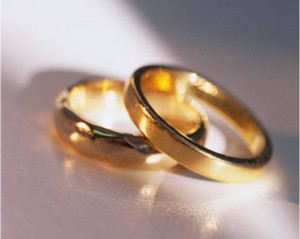 Why are we so compelled to marry? Why is it that young adults, even after seeing the fallout of the divorce rate among their friends, still overwhelmingly express their intent to marry at some point in their lives? A recent Pew research study noted that nearly 50% of young adults feel that marriage, as an institution, is obsolete; while at the same time, nearly 70% have an optimistic view of marriage and the family for the future. Go figure!
Why are we so compelled to marry? Why is it that young adults, even after seeing the fallout of the divorce rate among their friends, still overwhelmingly express their intent to marry at some point in their lives? A recent Pew research study noted that nearly 50% of young adults feel that marriage, as an institution, is obsolete; while at the same time, nearly 70% have an optimistic view of marriage and the family for the future. Go figure!
I think part of the reason we seem almost “pre-programmed” for marriage is that it truly is part of our genetic make up. It’s not just expedient or a convenient tool for getting our needs met or our goals reached – there’s something dramatically more profound at play.
When HaShem takes the newly created Chava and brings her to Adam, he recognizes there’s something unique about her. But, a careful reading of the text shows us that, after having just completed a tour of the world’s first zoo, and the subsequent long nap, his appreciation for Chava wasn’t just in her pretty eyes or her silky long hair; “this time it is bone of my bones and flesh of my flesh…” What made Chava unique and special wasn’t the lack of horns, spikes, or blubber. What made Chava unique to Adam was in his realization that she and he were biologically one and the same.
It is for this reason that the text continues to note, “Therefore a man should leave his father and mother and cling to his wife, and they should be as one flesh.” Poetically beautiful, to be sure, but what does it actually mean? In light of what we are saying about Chava’s uniqueness, it makes perfect sense. Only now that you have met each other, not just your “soul”- mate but your “body”- mate, so to speak, can you leave your previous biological bond with your parents, and cling to your spouse.
When we say that marriage is about creating ONE-ness, it’s not just fluffy relationships talk, it’s something that, at least in potential, can be actually and practically real.
How do we do it?
The problem I find with some marriage seminars I’ve attended, is they stop here. They get to the point of telling me that marriage is about “one” building or “we” building, or that the marriage, as an organism in and of itself, needs care and nurturing. But it seems to end there without a good, hands-on explanation as to what it means for seemingly independent, autonomous beings to actually become one.
It’s all in what (or who – or how) you know…
Over the past several years, I’ve had the privilege of working together with Rabbi David Fohrman on a project he called Affairs of the Heart. It’s a small part of a large curriculum development initiative co-sponsored by The Areivim Philanthropic Group and Rabbi Raphael Butler’s Afikim Foundation. Rabbi Fohrman’s brilliant and creative style of analysis has opened the door to numerous innovative insights into relationships.
The answer, I’ve come to understand, is in a very simple, yet often poorly understood Hebrew word – da’as (knowledge). Da’as appears twice in the text of Bereishis. “The Tree” is called “the tree of knowledge of good and evil” and Adam and Chava’s intimate relationship is called knowing in the Biblical sense. Why? What do the two contexts have to do with each other.
I believe the explanation lies in our search for a tool for creating “one”. HaShem was not concerned with Adam and Chava knowing about right and wrong, or good and bad. You need to know what’s right and wrong so you can know what to do. It’s critical to know. But that’s as long as you can differentiate right from wrong. If you mix and confuse right and wrong or good and bad, and can no longer tell the difference between them, then you are in trouble. The tree was not a vehicle for conveying cognitive understanding – it was a tree of knowledge of good and bad – one that caused good and bad to merge into one, and with one bite, sin, disconnection, and evil became a very real reality.
If da’as means the creation of “one” then we can understand why the Torah uses the term to define intimacy as well. The Torah is not just telling us that Adam and Chava were intimate with one another. It’s not about the “act”, so to speak, it’s about what they created through that interaction. They used da’as to create “one.”
The evolution of da’as…
It turns out that knowledge is not a static state of being. What we understand about another, the depth of that knowledge, and the ability of a spouse to intuit, feel, and react to that knowledge is a constantly evolving process. Allowing myself to be known, to share increasingly deep, personal, and revealing levels of my “self,” requires many factors. The elements of relationship that allow for this shared knowledge do not come easily nor quickly. Safety, security, comfort or ease of vulnerability, commitment, and others, all contribute to an environment wherein a spouse feels they can share, and allow themselves to be known.
How long does one need to be in a relationship before feeling safe enough to share a secret? How much commitment must be demonstrated so that a spouse will allow themselves to be emotionally vulnerable? There is no formula. But, one thing is certain, it takes time. The process of opening up our various shells and doorways that allow peeks into our heart and soul is an ongoing, and challenging evolution.
What’s the trade off for all the hard work that’s involved in creating that growing da’as? What makes all the challenges worth it? Think for a moment about how it feels to have a best friend. Close your eyes and picture the last time you unloaded a very heavy secret or deep emotion with someone you knew loved you and cared for you. Someone with whom you knew you could feel safe and could trust with your deepest emotions. These feelings go way beyond good. There’s a depth of meaning and a profound sense of fulfillment that comes with a connection like that.
This is da’as. This is what it means to create “one.” It requires patience, fortitude, commitment, with a heavy sprinkling of selfless giving, compassion, and topped with a bit of love. This is what marriage is about.
If you ask me, it’s well worth it.
The words of this author reflect his/her own opinions and do not necessarily represent the official position of the Orthodox Union.



